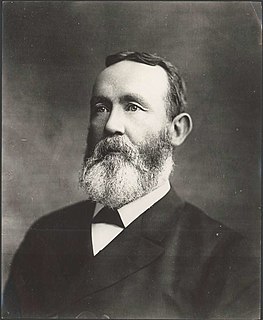Related Research Articles

Sir Joseph Palmer Abbott, was an Australian politician, pastoralist and solicitor.

William Francis Schey (1857–1913) was an Australian politician.

Francis Augustus Wright was a merchant sailor, gold miner, carrier and member of the Parliament of New South Wales.

John Sutherland was a builder and politician in colonial New South Wales.

William Stephen was an Irish-born Australian politician.
William Johnston Allen was an Irish-born Australian politician.
The 1894 New South Wales colonial election was for 125 electoral districts, with each district returning one member. The election was conducted on the basis of a simple majority or first-past-the-post voting system. There were three significant changes from the 1891 election, the abolition of multi-member constituencies, the abolition of plural voting where an elector had property or residence in more than one electorate and that polls for every district were held on the same day. The number of seats was reduced from 141 to 125. In this election, in 74 electorates the winning candidate received less than 50% of the votes, while 1 was uncontested. The average number of enrolled voters per electorate was 2,046, ranging from Lismore (1,360) to Marrickville (2,924).
The 1891 New South Wales election was for 141 members representing 74 electoral districts. The election was conducted on the basis of a simple majority or first-past-the-post voting system. In this election there were 39 multi-member districts returning 106 members. In these multi-member districts each elector could vote for as many candidates as there were vacancies. 7 of the 35 single member districts were uncontested. The average number of enrolled voters per seat was 2,166, ranging from Wilcannia (1,023) to Sturt (8,306). Sturt was an anomaly, as enrolments had increased by 5,376 since the 1889 election, and the next largest electorate was Canterbury (4,676).
The 1889 New South Wales colonial election was for 137 members representing 74 electoral districts. The election was conducted on the basis of a simple majority or first-past-the-post voting system. In this election there were 37 multi-member districts returning 100 members. In these multi-member districts each elector could vote for as many candidates as there were vacancies. 10 districts were uncontested. The average number of enrolled voters per seat was 1,955, ranging from Boorowa (1,142) to Canterbury (4,129).
The Bogan, an electoral district of the Legislative Assembly in the Australian state of New South Wales was created in 1859 and abolished in 1894.
Bourke, an electoral district of the Legislative Assembly in the Australian state of New South Wales was created in 1880 and abolished in 1904.
Central Cumberland, an electoral district of the Legislative Assembly in the Australian state of New South Wales was created in 1859 and abolished in 1894.
East Sydney, an electoral district of the Legislative Assembly in the Australian state of New South Wales was created in 1859 and abolished in 1894.
The Macleay, an electoral district of the Legislative Assembly in the Australian state of New South Wales, was created in 1880 and abolished in 1894.
Paddington, an electoral district of the Legislative Assembly in the Australian state of New South Wales, had two incarnations, from 1859 to 1920 and from 1927 to 1959.
Redfern, an electoral district of the Legislative Assembly in the Australian state of New South Wales, has had two incarnations, the first from 1880 to 1920, the second from 1927 to 1968.
South Sydney, an electoral district of the Legislative Assembly in the Australian state of New South Wales was created in 1880 and abolished in 1904.
A by-election was held for the New South Wales Legislative Assembly electorate of Redfern on 23 January 1882 because of the resignation of John Sutherland, ostensibly to accept an appointment to the Legislative Council, however he never took his seat in the council.
A by-election was held for the New South Wales Legislative Assembly electorate of Paddington on 12 January 1888 because William Trickett was appointed to the Legislative Council.

A by-election was held for the New South Wales Legislative Assembly electorate of Redfern on 8 September 1888 because of the death of James Farnell.
References
- 1 2 "Mr John Sutherland (1816-1889)". Former Members of the Parliament of New South Wales . Retrieved 25 September 2019.
- ↑ "Writ of election: Redfern". New South Wales Government Gazette (334). 28 June 1889. p. 4499. Retrieved 29 April 2021– via Trove.
- 1 2 Green, Antony. "1889 Redfern". New South Wales Election Results 1856-2007. Parliament of New South Wales . Retrieved 29 April 2021.
- ↑ Green, Antony. "1889 Redfern by-election". New South Wales Election Results 1856-2007. Parliament of New South Wales . Retrieved 29 April 2021.